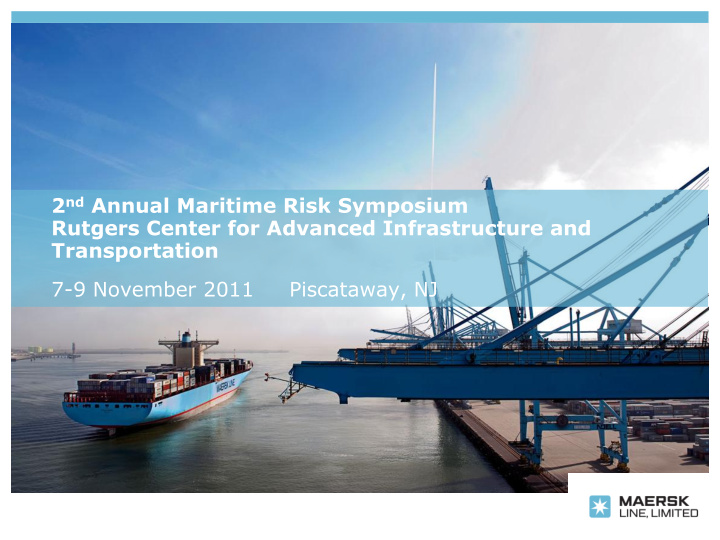



2 nd Annual Maritime Risk Symposium Rutgers Center for Advanced Infrastructure and Transportation 7-9 November 2011 Piscataway, NJ
Agenda 1. Risk Mitigation Post 9-11 2. Economy, Security, Environment 3. Maritime Security Risk Management 4. Environmental Risk Management 5. MLL Emergency Response 6. Teambuilding and Exercises
Our Challenge: The Transportation System is Designed to SPEED commerce, not IMPEDE commerce!
Post 9-11 Commercial Maritime Security 1. International Ship and Port Facility Security Code (ISPS) 2. Maritime Transportation and Security Act of 2002 (MTSA) 3. Security and Accountability For Every (SAFE) Port Act of 2006 4. Transportation Worker Identification Credential (TWIC) 5. C-TPAT/Container Security Initiative
Analyzing Risk 1. All Hazards 2. Developing Security Plans for New Ships 3. Operational Threat Assessments 4. BIMCO’s Automated Voyage Risk Assessment (AVRA) 4. Situational Risk Assessments 5. Using Exercises to Identify Risk 6. Independent Analysis for Risk Consequence
Piracy Security Umbrella 5
The Environment Coastal and Marine Spatial Planning MARPOL Annex VI emissions control Right Whale Seasonal Management Areas Ballast Water Management Grey Water Management Anti-Fouling Regulations Cold Iron Shut-downs 6
MLL Emergency Response 1. Crisis Management Plan 2. Business Continuity Plan 3. Emergency Operations Center
MLL Emergency Response 2011 Examples: Maersk Constellation Detention ASRY Shipyard Japanese Earthquake/Tsunami Fukushima Reactor Response Maersk Virginia/Hurricane Ophelia
Operations, Exercises and Lessons Learned 1. Maersk Alabama Attack 2. Maersk Michigan Terrorist Attack Exercise 2. Maersk Rhode Island Oil Spill TTX 3. Business Continuity Plan Exercise 4. Hurricane Irene BCP Operation
Questions & Answers 10
18 th Century Maritime Security The Great Chain – 1778 to 1782 West Point to Constitution Island 11
MLL welcomes the opportunity to help sustain our environment and economy through coastal and marine spatial planning Maersk Line, Limited is engaged in activities tied to National Coastal and Marine Spatial Planning • Ballast Water Technologies – Maersk Line, the global container shipping business, is leading the industry in developing new ballast water management systems • Right Whale Safety – Through our partnership with the National Marine Fisheries Service at NOAA, we are ensuring the safety of the whales while continuing to meet commercial requirements 12
Across its fleet, Maersk has implemented numerous efficiency- gaining and emission-reducing technologies and processes Cargo load optimization Voyage planning and execution Basic load optimization Optimum trim guidance for all vessel classes Main Engine efficiency Monitoring of new paint technologies Auxiliary Engine efficiency Cylinder oil optimization Monitoring of hull & propeller conditions Other Initiatives Propeller technology Alternative fuel tests QUEST: Low energy chilled enhancements containers New propulsion technologies Modified bulbous bow ISO 14001 certified Micro bubbles Crew awareness and Ballast water optimization engagement and treatment systems SOx scrubber studies 13
This year Maersk Line ordered 10 Triple-E vessels, the largest and most efficient vessels ever to be built Triple-E E conomy of Scale E nergy Efficiency E nvironmental Improvements • 18,000 20-foot containers • Each vessel is expected to be 1,310 feet long • 35% less fuel per container than similar vessels • Delivery between 2013 and 2015 • 16% more capacity than Maersk Line’s largest existing vessels (PS -class ships) 14
Fuel switches provide immediate air quality benefits Fuel Switch Programs California – Fuel switched from 24nm from shore. Maersk Line volunteered to lead the pilot program in 2006, and fuel switch has been required since July 2009 Houston – Voluntary program began in November 2009 with similar parameters to California, like 24nm Washington and British Columbia – Fuel switched at dock since pilot begin in 2006 Hong Kong – Voluntary program to switch to low sulfur fuels while at berth during 2011-2012. It is first of its kind in Hong Kong, Pearl River Delta, and Asia. March 31, 2006: Mærsk Mc-Kinney Møller stands on the dock at Pier 400 in Los Angeles with the Sine Maersk at berth behind him. Emissions Reductions: The vessel was the first to perform a fuel SOx: 95% switch as part of a Maersk Line environmental initiative in California. Particulate Matter: 86% NOx: 6-12% 15
Slow steaming has a resounding effect on emission reductions Speed/Bunker Curve - Example Figures are indicative only. 300.0 260 mt @ 24 knot 250.0 60 mts 200.0 200 mt @ 22 knot 40 mts 160 mt @ 20 knot 150.0 100.0 2kn 2kn 50.0 0.00 5.00 10.00 15.00 20.00 25.00 30.00 • Study started in 2007, covered 110 vessels – Maersk collaborated with engine manufacturers • Results: – OK to operate as low as 10% engine load – Traditional range is 40 – 60% – Manufacturers have changed recommendations • Over 100 vessels used since 2007, resulting in: – More flexible voyage & schedule planning – 10 – 30% fuel savings and reduced CO2 16
The U.S. Government is working with Maersk Line, Limited (MLL) to realize increased fuel efficiency and lower emissions Advanced Waste Heat Recovery System (AWHR) AWHR • MLL completed technical and cost analyses System for installing AWHR systems on two U.S. Schematic Navy (Military Sealift Command) ship classes • MLL expects to proceed with design and installation on selected ships later in 2011 Vessel Performance Management System (VPMS) • This program will support the Military Sealift Command’s fuel conservation goals by helping them operate and manage their vessels more efficiently Biofuel Experiment • In collaboration with the U.S. Navy, MLL will test the use of Navy-developed biofuels on marine engines 17
The development of clean energy markets aligns with Maersk Line, Limited’s values • Wind Energy – Wind is one potential solution to our country’s need for renewable energy – MLL wants to become a maritime partner for offshore and onshore wind energy projects • Liquefied Natural Gas (LNG) – LNG is clean fuel but adoption is limited by availability – MLL is looking to transport small-scale quantities of LNG safely, reliably and economically – We have developed 2 articulated tug-barge (AT/B) concepts with Argent Marine to distribute LNG – bulk and intermodal 18
Recommend
More recommend